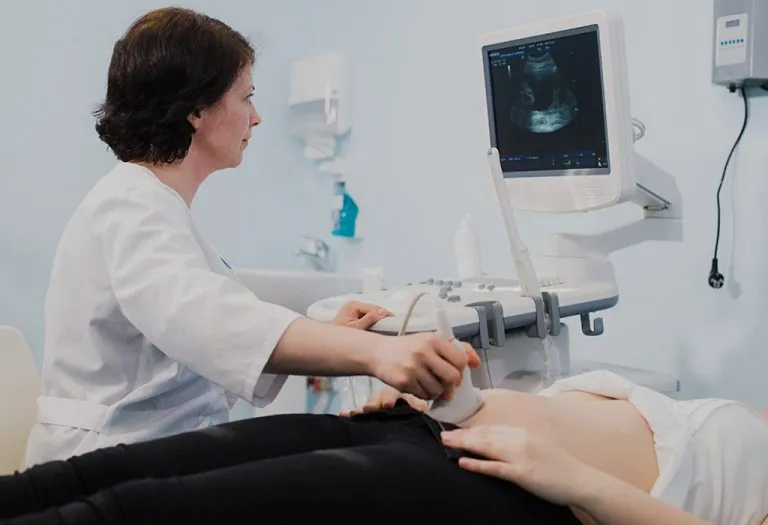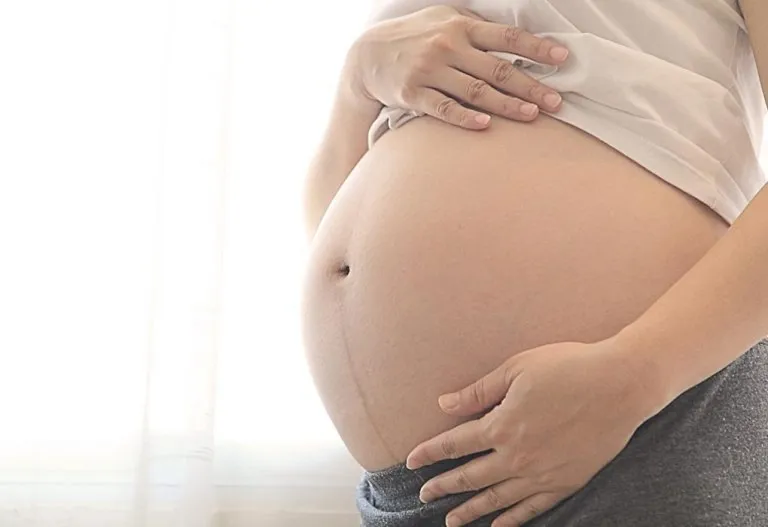Umbilical Hernia During Pregnancy – Causes, Symptoms and Preventions

During pregnancy, your body experiences certain changes due to hormonal imbalances, and you must be prepared to tackle them effectively. While there are a lot of changes taking place internally, many start making their appearance during the end of the first or the beginning of the second trimester and continue till you deliver. One such prominent change is a protruding belly button. It is a harmless and painless state when your belly button protrudes due to the pressure of the baby within.
Sometimes, it turns into an umbilical hernia during pregnancy, which requires medical attention. During pregnancy, the belly button pops out. To grow and thrive, the little one needs space, and that is why it exerts pressure on the organs, resulting in a protruding navel.
What Is Umbilical Hernia?
An umbilical hernia occurs when part of the intestine or fatty tissue protrudes through a weak spot in the abdominal wall near the navel, creating a noticeable bulge (1). It is common in infants, often resolving on its own by age 1-2, but can also occur in adults due to factors like obesity, pregnancy, or heavy lifting. While usually painless in infants, adults may experience discomfort, and complications like strangulation (loss of blood supply to the trapped tissue) are rare but require immediate medical attention. Treatment may involve monitoring in infants or surgical repair in adults or persistent cases.
Different Types of Hernia During Pregnancy
While hernias during pregnancy are not extremely common, they can cause discomfort and, in rare cases, complications. Understanding the types of hernias that may occur can help in identifying symptoms and seeking timely medical care.
- Umbilical Hernia: This occurs near the navel due to the stretching of the abdominal wall. It is more common in women who have had multiple pregnancies or pre-existing weakness in the abdominal muscles (2).
- Incisional Hernia: If a woman has had previous abdominal surgery (e.g., a C-section), the surgical scar may weaken, allowing tissue to protrude through the incision site (3).
- Inguinal Hernia: Though less common during pregnancy, an inguinal hernia can develop in the groin area due to increased pressure on the abdominal cavity. It may cause a noticeable bulge and discomfort (4).
Causes of Umbilical Hernia in Pregnancy
During pregnancy, the body undergoes significant changes, including increased abdominal pressure and stretching of the abdominal muscles, which can sometimes lead to the development of an umbilical hernia. Understanding the causes can help in managing and preventing complications (5).
1. Increased Abdominal Pressure
As the uterus expands to accommodate the growing baby, it places additional pressure on the abdominal wall, which can weaken the area around the navel and lead to a hernia.
2. Weakened Abdominal Muscles
Pregnancy can stretch and weaken the abdominal muscles, especially in women who have had multiple pregnancies or pre-existing muscle weakness, making them more susceptible to hernias.
3. Genetic or Congenital Factors
Some women may have a natural predisposition to weaker connective tissue or a larger umbilical ring, increasing the likelihood of developing an umbilical hernia during pregnancy.
Symptoms of Umbilical Hernia While Pregnant
While many cases of umbilical hernia are mild and asymptomatic, some women may experience noticeable symptoms that require medical attention. Recognizing these symptoms early can help in managing the condition and preventing potential complications (6).
- A visible bulge or swelling near the navel, which may become more prominent when coughing, sneezing, or straining.
- Mild to moderate discomfort or pain around the umbilical area, especially during physical activity.
- Tenderness or a feeling of pressure at the site of the bulge.
- Redness or discoloration around the hernia, which may indicate inflammation.
- Nausea or vomiting, which could signal a more serious complication like strangulation.
- A feeling of heaviness or pulling in the abdominal area.
- The bulge may temporarily reduce in size when lying down.
- In rare cases, severe pain and inability to push the bulge back in, which may indicate an incarcerated or strangulated hernia (a medical emergency).
- Digestive issues, such as constipation or bloating, if the hernia affects intestinal function.
Who Are at Risk of Getting Umbilical Hernia When Pregnant
Certain factors during pregnancy can increase the likelihood of developing an umbilical hernia, which occurs when tissue or part of the intestine protrudes through a weak spot near the navel. Understanding these risk factors can help in taking preventive measures and seeking timely medical advice (7).
- Women with multiple pregnancies
- Overweight or obese women
- Women with a history of umbilical hernias
- Women carrying multiples (twins, triplets, etc.)
- Women with weak abdominal muscles
- Women who have had abdominal surgery
- Genetic predisposition
Risks of an Umbilical Hernia During Pregnancy
What happens if you have an umbilical hernia while pregnant? If you have an umbilical hernia during pregnancy, it may keep on increasing. Listed below are some complications that pregnant women may face because of the umbilical hernia.
- Pregnancy causes the hernia to grow in size. This increase in hernia may put the foetus at risk.
- In pregnancy, bowel movements are also affected because of the umbilical hernia. If the opening is too wide, the umbilical hernia can force the bowel out. In such a condition, bowel movements are cut off, which can be detrimental for your pregnancy.
- Nausea, excessive vomiting, fever, and pain in the umbilical area are some other complications of an umbilical hernia during pregnancy.
- If the bulge is clearly visible, then umbilical hernia might be in bad condition. In such a situation, you should immediately consult your doctor.
Delivery With a Hernia
Women get apprehensive if they are pregnant with an umbilical hernia. But there is no need to worry as even after having a hernia, you can have a normal delivery (8). If the size of the hernia is small, your gynaecologist may suggest that you proceed with normal delivery. However, when the hernia is large and low in your abdomen, doctors may recommend a cesarean delivery. Another condition when the doctor suggests a c-section delivery is when you have had a c-section delivery before.
Does It Affect Your Baby?
A navel protruding during pregnancy generally does not affect the baby, as it involves the mother’s abdominal wall and does not interfere with fetal development (9). However, it can cause discomfort or pain for the mother, and in rare cases, complications like incarceration or strangulation (loss of blood supply to the trapped tissue) may require urgent medical attention. Most hernias do not impact delivery, but if the hernia is large or problematic, your healthcare provider may recommend a cesarean section to avoid additional strain. Regular monitoring ensures both mother and baby remain healthy.
Treatment for Umbilical Hernia
Treatment for an umbilical hernia depends on its severity and symptoms. While many cases resolve on their own, some may require medical intervention or lifestyle adjustments to manage discomfort and prevent complications.
1. Observation and Self-Care
In most cases, doctors recommend monitoring the hernia, as it often resolves on its own. Wearing loose clothing can help avoid irritation around the navel.
2. Surgical Intervention
If the hernia causes pain, grows larger, or becomes incarcerated or strangulated, minor surgery (herniorrhaphy) may be recommended to repair the abdominal wall and prevent complications (10).
Prevention of Umbilical Hernia in Pregnancy
While it may not always be possible to completely prevent a painful umbilical hernia during pregnancy, certain measures can help reduce the risk or minimize the severity of the condition. Here are some practical steps to consider:
- Avoid excessive weight gain during pregnancy to reduce unnecessary strain on the abdominal wall.
- Avoid heavy lifting, and if necessary, use your legs instead of your back or abdomen to lift objects.
- Engage in safe, pregnancy-approved exercises to strengthen your core muscles, such as prenatal yoga or pelvic tilts.
- Prevent constipation by eating a fiber-rich diet and staying hydrated to avoid straining during bowel movements.
- Maintain good posture to distribute abdominal pressure evenly and reduce stress on the abdominal muscles.
- Consider using maternity support belts to provide additional support to the abdominal area.
- Avoid overexertion and take breaks when needed to prevent unnecessary pressure on your abdomen.
FAQs
1. Can coughing or sneezing make an umbilical hernia worse?
Frequent coughing or sneezing can increase abdominal pressure, potentially worsening an existing umbilical hernia or contributing to its development. Managing conditions like allergies or colds can help reduce this risk.
2. Do umbilical hernias ever recur after surgery?
While surgery is generally effective, umbilical hernias can recur, especially if there is significant strain on the abdominal wall (e.g., from heavy lifting, pregnancy, or obesity). Following post-surgery guidelines can help minimize this risk.
3. Can an umbilical hernia cause digestive issues like bloating or constipation?
Yes, in rare cases, if the hernia traps a portion of the intestine, it can lead to digestive symptoms such as bloating, constipation, or even nausea. This is more common in larger hernias and may require medical attention.
If you experience a hernia or protruding navel during pregnancy, do not worry. Simple consult a doctor and look at the options. Pregnancy is a wonderful experience, so, don’t let a hernia stop you from enjoying it. Remember to take precautions and do the necessary exercises to have a safe and healthy pregnancy.
References/Resources:
1. Umbilical hernia; Mayo Clinic; https://www.mayoclinic.org/diseases-conditions/umbilical-hernia/symptoms-causes/syc-20378685
2. Umbilical Hernia; Johns Hopkins Medicine; https://www.hopkinsmedicine.org/health/conditions-and-diseases/hernias/umbilical-hernia
3. Incisional Hernia; Johns Hopkins Medicine; https://www.hopkinsmedicine.org/health/conditions-and-diseases/hernias/incisional-hernia
4. Inguinal Hernia; NIH; https://www.niddk.nih.gov/health-information/digestive-diseases/inguinal-hernia
5. Umbilical Hernia; Cleveland Clinic; https://my.clevelandclinic.org/health/diseases/umbilical-hernia
6. Adult Umbilical Hernia; American College of Surgeons; https://www.facs.org/for-patients/the-day-of-your-surgery/adult-umbilical-hernia/
7. Umbilical hernia repair; NHS; https://www.nhs.uk/conditions/umbilical-hernia-repair/
8. Hernias during pregnancy; The British Hernia Centre; https://www.hernia.org/types/hernias-during-pregnancy/
9. Hernia During Pregnancy; American Pregnancy Association; https://americanpregnancy.org/healthy-pregnancy/pregnancy-complications/hernia-during-pregnancy/
10. Coste. A, Bamarni. S, Leslie. S; Umbilical Hernia; National Library of Medicine; https://www.ncbi.nlm.nih.gov/books/NBK459312/
Also Read:
Pregnancy Hernia
Belly Button in Pregnancy
Cystic Fibrosis (CF) and Pregnancy
Retroverted Tilted Uterus in Pregnancy
Bacterial Vaginosis (BV) during Pregnancy
Was This Article Helpful?
Parenting is a huge responsibility, for you as a caregiver, but also for us as a parenting content platform. We understand that and take our responsibility of creating credible content seriously. FirstCry Parenting articles are written and published only after extensive research using factually sound references to deliver quality content that is accurate, validated by experts, and completely reliable. To understand how we go about creating content that is credible, read our editorial policy here.























